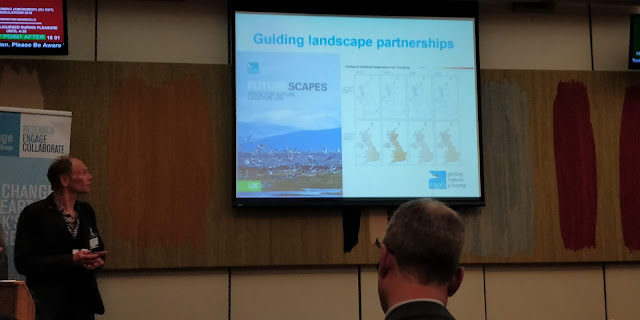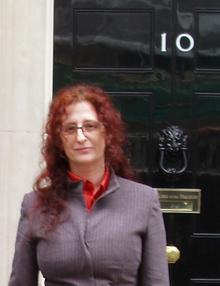A new report backed by MPs and launched by Minister for Climate Change Lord Duncan on 15 October 2019, calls for an urgent Green Heat Roadmap by 2020 to scale low carbon heating technologies and help Britain’s homeowners access the advice they need to take smarter greener choices on heating their homes. The year-long study by UK think-tank Policy Connect warns that the UK will miss its 2050 net-zero climate target “unless radical changes in housing policy, energy policy and climate policy are prioritised”. Dr Colin Nolden was at the launch on behalf of the Cabot Institute for the Environment and blogs here on the most interesting highlights of the report and questions raised.
Policy Connect had invited a range of industry, policy, academic and civil society representatives to the launch of their Uncomfortable Home Truths report. The keynote, no less than Lord Duncan of Springbank, Minister for Climate Change, and the high-level panel consisting of Maxine Frerk, Grid Edge Policy (Chair), Alan Brown MP, House of Commons (SNP), Dr Alan Whitehead MP, House of Commons (Labour), Dhara Vyas, Citizens Advice, Adam Turk, BAXI Heating (sponsor) and Mike Foster, EUA (Energy & Utilities Alliance), (sponsor), had been briefed to answer tough questions from the crowd given the UK’s poor track record in the area of heat and home decarbonisation.
The event started with an introduction by Jonathan Shaw, Chief Executive of Policy Connect, who introduced the panel and officially launched the report. Uncomfortable Home Truths is the third report of the Future Gas Series, the first two of which focused on low-carbon gas options. This last report of the series shifts the focus from particular technologies and vectors towards heating, households and consumers. Jonathan subsequently introduced the keynote speaker Lord Duncan of Springbank, Minister for Climate Change.
Lord Duncan supported the publication of this report as timely and relevant especially in relation to the heat policy roadmap that government intends to publish in 2020. He stressed the importance of a cultural shift which needs to take place to start addressing the issue of heat at household and consumer level. He was adamant that the government was aligning its policies and strategies with its zero-carbon target according to the Committee on Climate Change and guided by science and policy. In this context he bemoaned the drive by some country representatives to put into question the targets of the Paris Agreement on Climate Change which he had witnessed as the UK’s key representative at the run-up to COP25 in Chile. The 2020 roadmap will report on the decisions which will need to be taken in homes and in technology networks, ranging from heat pumps to hydrogen and low-carbon electricity to support their decarbonisation. It requires cross-party support while depending on more research and learning from successful examples in other European countries.
Although Lord Duncan suggested that ‘it’s easier to decarbonise a power plant than a terraced house’, he told the audience to take encouragement from the fuel shift from coal towards gas starting half a century ago. But in this context he once again stressed the cultural shift which needs to go hand-in-hand with government commitment and technological progression, using the example of TV-chefs shunning electric hobs as an indication of our cultural affinity for gas. As long as heating and cooking are framed around fossil fuels, there is little space in the cultural imagination to encourage a shift towards more sustainable energy sources.
 |
| “The example of TV-chefs shunning electric hobs is an indication of our cultural affinity for gas”. Image source. |
Among the questions following the keynote, one quizzed Lord Duncan about the process and politics of outsourcing carbon emissions. Lord Duncan stressed his support of Border Carbon Adjustments compliant with EU and global carbon policy ‘in lock-step with our partners’ to ensure that carbon emissions are not simply exported, which appears to support the carbon club concept. Another question targeted the UK’s favourable regulatory environment that has been created around gas, which has resulted in the EU’s lowest gas prices, while electricity prices are highest in Europe, due, among other things, to Climate Change Levies, which do not apply to gas, increasing by 46% on 1 April 2019. Lord Duncan pointed towards the ongoing review of policies ahead of the publication of the 2020 heat roadmap which will hopefully take a more vector- and technology-neutral approach. A subsequent rebuttal by a Committee on Climate Change (CCC) representative stressed the CCCs recommendation to balance policy cost between gas and electricity as on average only 20,000 heat pumps are sold in the UK every year (compared to 7 times as many in Sweden) yet the Renewable Heat Incentive is about to be terminated without an adequate replacement to support the diffusion of low-carbon electric heating technologies.
Lord Duncan stressed the need to create a simple ‘road’ which does not fall with changes in policy and once again emphasized the need for a cross-party road to support the creation of a low-carbon heating pathway. A UKERC representative asked about the government approach to real-world data as opposed to modelling exercises and their support for collaborative research projects as both modelling and competitive approaches have failed, especially in relation to Carbon Capture and Storage. Lord Duncan responded that the UK is already collaborating with Denmark and Norway on CCS and that more money is being invested into scalable and replicable demonstrators.
Following an admission wrapped in metaphors that a change in government might be around the corner and that roadmaps need to outlast such changes, Lord Duncan departed to make way for Joanna Furtado, lead author of the Policy Connect report. She gave a very concise overview of the main findings and recommendations in the report:
- The 80% 2050 carbon emission reduction target relative to 1990 already required over 20,000 households to switch to low-carbon heating every week between 2025 and 2050. The zero-carbon target requires even more rapid decarbonisation yet the most successful policy constellations to date have only succeeded in encouraging 2,000 households to switch to low-carbon heating every week.
- This emphasizes the importance of households and citizens but many barriers to their engagement persist such as privacy issues, disruption associated with implementation, uncertainly, low priority, lack of awareness and confusion around best approaches, opportunities, regulations and support.
- Despite the focus on households, large-scale rollout also requires the development of supply chains so at-scale demonstrations need to go hand-in-hand with protection and engagement of households by increasing the visibility of successful approaches. Community-led and local approaches have an important role to play but better monitoring is required to differentiate between more and less successful approaches.
- Protection needs to be changed to facilitate the inclusion of innovative technologies which are rarely covered while installers need to be trained to build confidence in their installations.
- Regional intermediaries, such as those in Scotland and Wales, need to be established to coordinate these efforts locally while at national level a central delivery body such as the one established for the 2020 Olympics in London needs to coordinate the actions of the regional intermediaries.
- Ultimately, social aspects are critical to the delivery of low-carbon heat, ranging from the central delivery body through regional intermediaries down to households and citizens.
 |
| Image source. |
Chaired by Maxine Frerk of Grid Edge Policy, the panel discussion kicked off with Alan Brown who stressed the urgency of the heating decarbonisation issue as encapsulated by Greta Thunberg and Extinction Rebellion and the need to operationalize the climate emergency into actions. He called for innovation in the gas grid in line with cautions Health and Safety Regulation alterations. Costs also need to be socialised to ensure that the low-carbon transition does not increase fuel poverty. His final point stressed the need reorganize government to make climate change and decarbonisation a number 1 priority.
Dr Alan Whitehead, who has been involved with the APPCCG from the beginning, emphasized how discussions around heat decarbonisation have progressed significantly in recent years and especially since the publication of the first report of this series. He suggested that the newest report writes the government roadmap for them. In relation to the wider context of decarbonising heat, Alan Whitehead encouraged a mainstreaming of heating literacy similar to the growing awareness of plastic. He also stressed how far the UK is lagging behind compared to other countries and this will be reflected in upcoming policies and roadmaps. As his final point Alan Whitehead cautioned that the low-intrusion option of gas-boiler upgrades from biomethane to hydrogen ignores the fact that greater change is necessary for the achievement of the zero-carbon target although he conceded that customer acceptance of gas engineer intervention appears to be high.
Dhara Vyas presented Citizens Advice perspective by stressing the importance of the citizen-consumer focus. Their research has revealed a lack of understanding among landlords and tenants of the rules and regulations that govern heat. She suggested that engagement with the public from the outset is essential to protect consumers as people are not sufficiently engaged with heating and energy in general. Even for experts it is very difficult to navigate all aspects of energy due to the high transaction costs associated with engagement to enable a transition on the scale required by government targets.
Finally, representatives of the two sponsors BAXI and the Energy & Utility Alliance made a rallying call for the transition of the gas grid towards hydrogen. Adam Turk emphasized the need to legislate and innovate appropriately to ensure that the 84% of households that are connected to the gas grid can receive upgrades to their boilers to make them hydrogen ready. Similarly, Mike Foster suggested that such an upgrade now takes less than 1 hour and that the gas industry already engages around 2 million consumers a year. Both suggested that the gas industry is well placed to put consumers at the heart of action. They were supported by several members of the audience who pointed towards the 150,000 trained gas service engineers and the ongoing distribution infrastructure upgrades towards plastic piping which facilitate a transition towards hydrogen. Other members of the audience, on the other hand, placed more emphasis on energy efficiency and the question of trust.
Sponsorship of the Institution of Gas Engineers & Managers, EUC (Energy & Utility Alliance) and BAXI Heating was evident in the title Future Gas Series and support for hydrogen and ‘minimal homeowner disruption’ boiler conversion to support this vector shift among members of the audience was evident. Nevertheless, several panel members, members of the audience and, above all, Lord Duncan of Springbank, stressed the need to consider a wider range of options to achieve the zero-carbon target. Electrification and heat pumps in particular were the most prominent among these options. Energy efficiency and reductions in energy demand, as is usual at such events, barely received a mention. I guess it’s difficult to cut a ribbon when there’s less of something as opposed to something new and shiny?
———————————————-
This blog is written by Dr Colin Nolden, Vice-Chancellor’s Fellow, University of Bristol Law School and Cabot Institute for the Environment.
 |
| Colin Nolden |



.jpg)

















